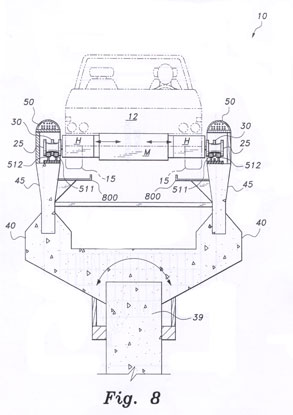Vehicles
Section Links: What | Glideway | Vehicle | Patent
Personal Vehicles
The personal models will be similar in design and utility as conventional vehicles of today. There will be limitations on physical dimensions and weight as all bimodals are required to meet strict specifications in order to insure safety and proper operating characteristics when operating on the glideways. They will be equipped to travel both on conventional roadways and on the BiModal Glideway. Transferring from roadway to glideway will be seamless.
Commercial Vehicles
The commercial bimodal consists of two separate subsystems. One is primarily for transferring commercial materials, cargo, equipment, liquids etc, between controlled locations or terminals. They are driverless bimodals stripped of all automobile features while retaining full glideway capabilities. They can only operate on glideways or in industrial type complexes having additional methods for transporting driverless vehicles to or from exclusive glideway ramps.
This concept is designed to support industries requiring frequent transportation of moderate loads (less than 4000 lbs.) between plants, business locations, etc., where there is no need for a driver. The US mail is a good example for using both driverless, for between major distribution centers, and driver vehicles for local distribution. The driverless bimodals can be a minivan in size without engines, seats, transmission, fuel tanks, tires, or windows, thus saving space and cost. They do need some form of receiving and sending vehicle temporarily for maneuvering these unmanned mini “boxcars” to off or on loading docks. These handling vehicles at either end of a destination must be capable of delivering the unmanned driverless vehicles on or off their exclusive glideway ramps and branch lines. There should be a great financial demand for the commercial driverless system once a sufficient number of glideways were extended over a large area of the US.
The second bimodal commercial subsystem is the development for a relatively fast safe mass transit system utilizing the fully automated driverless minibus to transport people between exclusive stations. These vehicles would be permanently connected to a glideway and would travel a round robin using exclusive ramps and branch lines for each station, stopping long enough to embark or debark passengers at a desired station. Passengers would select their destinations after entering the vehicle which would only stop at selected stations unless the head count from the fare collector indicated there was sufficient room for additional passengers at succeeding stations. The driverless vehicle should become a very important link in the bimodal commercial and public systems due in part to its light weight, extra interior space, safety, reliability, fast portal-to-portal delivery, and overall economy.
